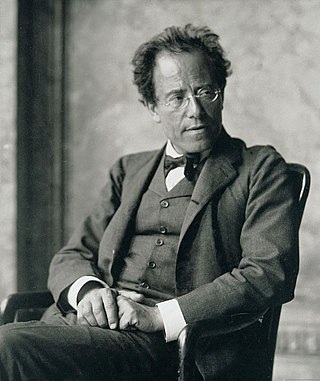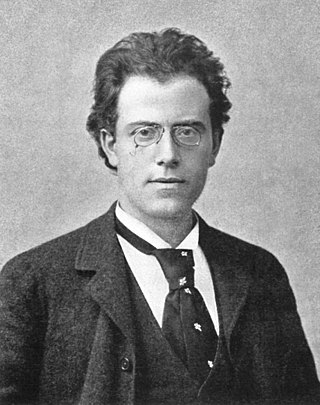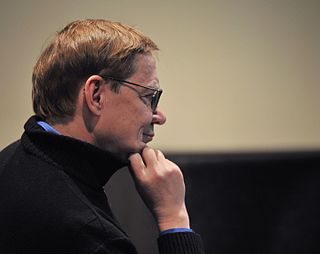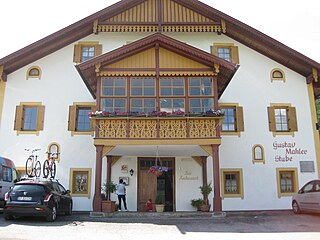
Gustav Mahler was an Austro-Bohemian Romantic composer, and one of the leading conductors of his generation. As a composer he acted as a bridge between the 19th-century Austro-German tradition and the modernism of the early 20th century. While in his lifetime his status as a conductor was established beyond question, his own music gained wide popularity only after periods of relative neglect, which included a ban on its performance in much of Europe during the Nazi era. After 1945 his compositions were rediscovered by a new generation of listeners; Mahler then became one of the most frequently performed and recorded of all composers, a position he has sustained into the 21st century.

Bruno Walter was a German-born conductor, pianist and composer. Born in Berlin, he escaped Nazi Germany in 1933, was naturalised as a French citizen in 1938, and settled in the United States in 1939. He worked closely with Gustav Mahler, whose music he helped to establish in the repertory, held major positions with the Leipzig Gewandhaus Orchestra, New York Philharmonic, Concertgebouw Orchestra, Salzburg Festival, Vienna State Opera, Bavarian State Opera, Staatsoper Unter den Linden and Deutsche Oper Berlin, among others, made recordings of historical and artistic significance, and is widely considered to be one of the great conductors of the 20th century.

The Symphony No. 1 in D major by Gustav Mahler was mainly composed between late 1887 and March 1888, though it incorporates music Mahler had composed for previous works. It was composed while Mahler was second conductor at the Leipzig Opera in Germany. Although in his letters Mahler almost always referred to the work as a symphony, the first two performances described it as a symphonic poem and as a tone poem in symphonic form, respectively. The work was premièred at the Vigadó Concert Hall in Budapest, Hungary, in 1889, but was not well-received. Mahler made some major revisions for the second performance, given at Hamburg, Germany, in October 1893; further alterations were made in the years prior to the first publication, in late 1898. Some modern performances and recordings give the work the title Titan, despite the fact that Mahler only used this label for the second and third performances, and never after the work had reached its definitive four-movement form in 1896.

The Symphony No. 8 in E-flat major by Gustav Mahler is one of the largest-scale choral works in the classical concert repertoire. As it requires huge instrumental and vocal forces it is frequently called the "Symphony of a Thousand", although the work is normally presented with far fewer than a thousand performers and the composer did not sanction that name – actually, he disapproved of it. The work was composed in a single inspired burst at his Maiernigg villa in southern Austria in the summer of 1906. The last of Mahler's works that was premiered in his lifetime, the symphony was a critical and popular success when he conducted the Munich Philharmonic in its first performance, in Munich, on 12 September 1910.

The Symphony No. 2 in C minor by Gustav Mahler, known as the Resurrection Symphony, was written between 1888 and 1894, and first performed in 1895. This symphony was one of Mahler's most popular and successful works during his lifetime. It was his first major work that established his lifelong view of the beauty of afterlife and resurrection. In this large work, the composer further developed the creativity of "sound of the distance" and creating a "world of its own", aspects already seen in his First Symphony. The work has a duration of 80 to 90 minutes, and is conventionally labelled as being in the key of C minor; the New Grove Dictionary of Music and Musicians labels the work's tonality as C minor–E♭ major. It was voted the fifth-greatest symphony of all time in a survey of conductors carried out by the BBC Music Magazine.

Alma Mahler-Werfel was an Austrian composer, author, editor, and socialite. Musically active from her early years, she was the composer of nearly fifty songs for voice and piano, and works in other genres as well. 17 songs are known to have survived. At 15, she was mentored by Max Burckhard.

The Symphony No. 10 in F-sharp major by Gustav Mahler was written in the summer of 1910, and was his final composition. At the time of Mahler's death, the composition was substantially complete in the form of a continuous draft, but not fully elaborated or orchestrated, and thus not performable. Only the first movement is regarded as reasonably complete and performable as Mahler intended. Perhaps as a reflection of the inner turmoil he was undergoing at the time, the 10th Symphony is arguably his most dissonant work.

Kalevi Ensio Aho is a Finnish composer.
Detlev Glanert is a German opera composer, who has also composed numerous works for chamber and full orchestra, including three symphonies.

Neustadt is one of the inner-city districts of the Free and Hanseatic City of Hamburg, Germany.

Chorale is the name of several related musical forms originating in the music genre of the Lutheran chorale:

The Composers Quarter Hamburg is a gathering of six museums in the Peterstraße in Hamburg-Neustadt, Germany. The associated museums have one or two classical composers as a theme who were born or have lived in the city of Hamburg.

The Brahms Museum is a museum in the Composers Quarter in Hamburg-Neustadt, Germany. It is dedicated to the classical composer Johannes Brahms.

The Telemann Museum is a museum in the Composers Quarter in Hamburg-Neustadt, Germany. It was founded in 2011 and is dedicated to the classical composer Georg Philipp Telemann.

The Fanny & Felix Mendelssohn Museum is a museum in the Composers Quarter in the Neustadt district of Hamburg, Germany. It is dedicated to the classical composers and siblings Fanny and Felix Mendelssohn. It opened on 29 May 2018.

The composing hut of Gustav Mahler, German: Gustav Mahler-Komponierhäuschen, is a little museum and memorial in Steinbach at lake Attersee in Upper Austria. It is dedicated to the classical composer Gustav Mahler (1860–1911). In this hut he retreated from 1893 to 1896 in order to compose music. Since 1985 a permanent exhibition can be seen here.

The composing hut of Gustav Mahler is a small museum and memorial in Maiernigg, near Maria Wörth in Carinthia, Austria. It is dedicated to the classical composer Gustav Mahler (1860–1911). He retreated into this hut from 1900 to 1907 to compose music. Since 7 July 1986, a permanent exhibition has been established here.

The Gustav Mahler Stube, formerly Trenkenhof, is a farmhouse in Altschluderbach, near Toblach in South Tyrol, Italy. It has a restaurant with a Tyrolean cuisine and two apartments. The Stube furthermore manages an animal park with domestic, wild and exotic animals.
Henny Wolff was a German soprano concert singer and voice teacher. She made an international career, known for performing music by Bach and Handel, but also performing contemporary classical music. Composers wrote music for her and performed with her, such as Hermann Reutter. She was a voice teacher at the Bonn Conservatory, in Berlin, and from 1950 to 1964 at the Musikhochschule Hamburg. She was awarded the city's Johannes Brahms Medal.

Klaus Hinrich Stahmer is a German composer and musicologist. He gave added to the development of music in the 1980s through multimedia works, including music with sound art sculptures and musical graphic). He also broke new artistic ground with his compositions for non-European instruments, which can be classified as world music.




















